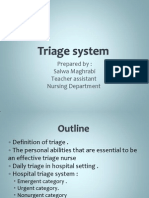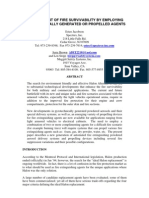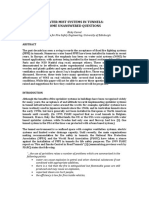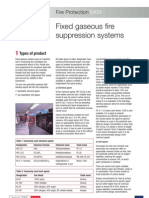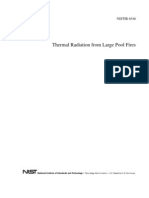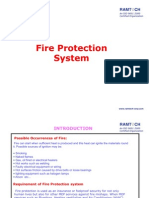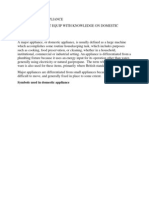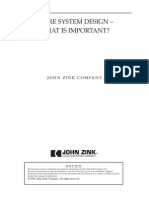Advances in Fire Suppression Systems: Construction Technology Update
Advances in Fire Suppression Systems: Construction Technology Update
Uploaded by
Ravi Sankar VenkatesanCopyright:
Available Formats
Advances in Fire Suppression Systems: Construction Technology Update
Advances in Fire Suppression Systems: Construction Technology Update
Uploaded by
Ravi Sankar VenkatesanOriginal Title
Copyright
Available Formats
Share this document
Did you find this document useful?
Is this content inappropriate?
Copyright:
Available Formats
Advances in Fire Suppression Systems: Construction Technology Update
Advances in Fire Suppression Systems: Construction Technology Update
Uploaded by
Ravi Sankar VenkatesanCopyright:
Available Formats
Construction Technology Update No.
75
Advances in Fire Suppression Systems
By Andrew Kim Fire suppression systems for the protection of buildings have evolved in response to new requirements, environmental pressures and advances in technology. This Update provides an overview of four recently developed systems, reviews research on the performance of each, and provides guidance on system selection, design and use.
Suppressing fire by throwing water onto it has been used since ancient times. To provide an automatic spray of water to control a fire, sprinkler systems were developed in the late 19th century. Since then, automatic sprinklers have become the most common fixed fire suppression system for providing fire safety in buildings. Sprinklers control fire development by wetting and cooling the fuel surface. They are effective for fires involving solid materials (referred to as solid fuels) but are not effective for flammable liquids (called liquid fuels) such as gasoline, diesel and jet fuels. The old adage oil and water do not mix must be kept in mind. Fire suppression systems for liquid fuels typically use foam or dry chemicals, which cover the There are two basic methods for applying an extinguishing agent: total flooding and local application. Total flooding means applying an extinguishing agent to a three-dimensional enclosed space in order to achieve a concentration of the agent adequate to extinguish the fire. These types of systems may be operated automatically or manually. Local application means applying an extinguishing agent directly onto a fire (usually a two-dimensional area), or into the threedimensional region immediately surrounding the substance or object on fire. The main difference between local application and total flooding design is the absence of physical barriers enclosing the fire space. fuel surface, hence limiting thermal feedback to the liquid fuel surface and fuel vapourization. Fires in electrical and electronic facilities call for special solutions for suppression. Carbon dioxide (CO2) systems were used early on. They deliver large amounts of CO2 to the fire area to reduce the oxygen concentration to below the level required for combustion. For total flooding systems, in which pressurized cylinders are connected to a fixed piping and nozzle system to discharge the gas into an enclosed space, the oxygen concentration can be reduced to below the level required by occupants. As a result, CO2 systems are typically limited to unoccupied spaces. In the 1940s, there was a major effort to come up with a more effective fire suppression agent than the ones being used at that time. This led to the development of halon chemicals, including Halon 1301, which was typically used for total flooding applications. Halons are excellent fire suppressants, but they contribute significantly to stratospheric ozone depletion. As a result, fire protection halons were phased out in developed countries around 1990 when an international consensus (the Montreal Protocol) was reached to regulate the use of ozone-depleting substances.
The phase-out led to extensive research to find halon substitutes that would work well for various applications without harming the environment and human health. Several new fire suppression systems have been developed and some old approaches have gained renewed interest. This Update reviews four such technologies: inert and halocarbon gaseous agents, water mist systems, compressed-air-foam systems, and solid gas generators. A subsequent Update will focus solely on compressed-air foam technology, drawing on extensive research carried out by the NRC Institute for Research in Construction (NRC-IRC).
Gaseous Systems
Two types of gaseous agents are available for use in total flooding systems: halocarbon agents and inert gases. A general requirement for such systems is that the enclosure must be capable of holding the gas and be able to withstand the high pressures produced during discharge. To address limitations and proper use of systems involving gaseous agents, the National Fire Protection Association published NFPA 2001[1] Figure 1. Weight and space Standard on Clean Agent Fire issues can arise with the use Extinguishing Systems. NFPA 2001 is not a design handbook of cylinders but rather a guide for those dealing with clean agent extinguishing systems, to help ensure that such equipment will function as intended. The standard contains information on the use and limitations of clean agents, such as the physical properties of halocarbon and inert agents, maximum concentrations allowed, and toxicity of the agents. It also addresses system components and hardware, system design, inspection, maintenance, testing and training. Halocarbon Agents Halocarbon agents are chemicals similar to halon except that their molecular structure has been modified to reduce the number of, or to eliminate completely, the chlorine and bromine atoms, which are responsible for ozone depletion. These agents extinguish fires primarily by cooling.
Acceptance of a halocarbon agent by regulatory authorities hinges on the agents toxicity. Two toxicological aspects must be considered. One is the toxicity of the agent itself, and the other is the toxicity of combustion by-products of the agent produced under fire conditions. Results from both small-scale and fullscale tests have shown that the halocarbon replacement systems extinguish fires well, though not as effectively as halons. To provide the same level of fire protection as halons, larger amounts of halocarbon agents are needed. This means larger and heavier cylinders are required, which may create weight and space problems (Figure 1). The test results also show that halocarbon agents produce five to ten times more toxic gases than Halon 1301 during fire suppression. These gases include hydrogen fluoride (HF) and carbonyl difluoride (COF2), with levels produced in test fires significantly exceeding all human exposure limits. The levels of HF and COF2 likely to be produced in actual applications will depend on many factors such as agent type and concentration, fire type and size, and discharge and extinguishment times. Halocarbon agents also produce carbon monoxide (CO) during fire extinguishment, which could be another safety issue, depending on the concentrations and the occupancy of the space. Some halocarbon agents have a long Atmospheric Life Time (ALT) and could contribute to global warming. This may become a determining factor in selecting suitable suppression agents in the future. Inert Gas Agents Inert gas agents are applied as total flooding agents. They extinguish fire by displacing the oxygen in the enclosed space and eventually reducing its concentration below the level required for combustion. Inert gases, such as nitrogen, argon and helium, are clean and naturally occurring, have zero ozone depletion potential and no global warming potential. They are not subject to thermal decomposition when used in extinguishing fires, and hence form no combustion by-products. One of the disadvantages of using inert gas systems is that a large volume of agent is required to extinguish a fire. As well, inert gases cannot be liquefied and must be stored in cylinders as high pressure gases,
which has implications for space and weight. Inert gases also require a discharge system sufficiently robust to withstand the high pressures involved. The rapid displacement of oxygen, high noise levels and rapid cooling are also a concern if the agent is to be discharged into an occupied space.
Water Mist
The term "water mist" refers to fine water sprays in which 99% of the volume of the spray is in droplets smaller than 1000 microns in diameter. For water mist systems, a standard NFPA 750[2], Standard on Water Mist Fire Protection Systems, was developed by NFPA. The standard specifies minimum requirements for the design, installation, maintenance, and testing of water mist fire protection systems. It does not provide definitive fire performance criteria nor does it offer guidance on how to design a system to suppress a fire. Fire suppression by water mist is mainly by physical mechanisms. No significant chemical effects are involved. While early studies identified flame cooling and oxygen displacement as the dominant mechanisms, recent investigations suggest that there are additional ones. The main one is radiation attenuation, which can stop the fire from spreading to an un-ignited fuel surface and reduces the vapourization at the fuel surface. Tests conducted at NRC-IRC showed that the radiant heat transfer to the walls of the test compartment was reduced by more than 70%. Other secondary extinguishing mechanisms include dilution of flammable vapours released by the burning objects, and wetting and cooling of these objects by direct impingement. Water mist does not behave like a true gaseous agent. The NRC-IRC compartment tests showed that its effectiveness in fire suppression is substantially affected by the fire size, the degree of obstruction, ceiling height, and the ventilation conditions. Water mist characteristics, such as variety of drop sizes and spray momentum, have a direct influence on effectiveness. To effectively suppress a fire, a water mist system must generate and deliver optimum-sized droplets with an adequate concentration. The selection of the optimum size of droplets for the design of the system is dependent
on the potential size of the fire, properties of the combustibles, and the degree of obstruction and ventilation in the compartment. There is no one drop size distribution to fit all fire scenarios. There are several water mist systems available commercially. Some employ high or intermediate pressures of water through small orifices in a nozzle to produce the mist, while others use twin fluid nozzles (water and air). Water mist systems have demonstrated a number of advantages, such as good fire suppression capability, no environmental impact and no toxicity. As a result, they have been considered for numerous applications. One potential application is shipboard machinery spaces. Water mist systems are able to extinguish a wide variety of fires when natural ventilation, such as open doors and hatches are allowed, whereas gaseous agents were not effective under such conditions. Water mist systems also rapidly reduced the compartment temperature and significantly improved visibility. These advantages allow accessibility to the compartment during fire suppression. Another application where water mist has potential as an effective halon alternative is the protection of electronic equipment. The telecommunications industry and utilities have generally been reluctant to use water as a fire suppressant because of concerns about damage to electrical and electronic equipment. A preliminary study by NRC-IRC on the feasibility of using a water mist system to suppress in-cabinet electronic fires showed that the system was effective without causing short circuits or damage to the equipment. Recent NRC-IRC research[3] in a test compartment has shown that the fire suppression performance of water mist can be further improved by using a cycling discharge. This feature involves a continuous alternation of an ON and OFF cycle of the mist discharge. When a fire was minor, the extinguishment was easy and the contribution made by the cycling discharge was small. For more challenging fire scenarios, such as ventilated conditions, the cycling discharge significantly reduced extinguishment times and water requirements. More water vapour and combustion products were produced, which increased the rate of
oxygen depletion. In addition, the recurrent dynamic mixing created by a cycling discharge effectively dilutes the oxygen and fuel vapour available for the fire.
Compressed-Air Foam
For decades, foam systems have been used to provide fire protection in the chemical and petroleum industries and in military installations. The overall effectiveness of current fixed-pipe foam systems, which incorporate aspirating-type nozzles and blower-type foam generators, is limited since they are unable to provide foams with high injection velocities. As well, the foam produced using traditional systems is not as stable and consistent, and expansion ratios are not as high as desired for some applications, because the air to generate foam at the nozzle, which comes from the fire environment, may be contaminated. However, if compressed air is used for foam generation, the foam possesses superior quality and substantial injection velocity, as well as requiring a much smaller quantity of water and foam concentrates. Compressed-air foam (CAF) is generated by injecting air under pressure into a foam solution stream (Figure 2). The process of moving the solution and air mixture through the hose or piping, if done correctly, forms a foam. The energy for the CAF comes
Figure 2. Schematic of a CAF system
Figure 3. CAF extinguishment versus water (deluge) extinguishment
from the combined momentum of the foam solution and air. One significant advantage of such systems is the increased momentum of the foam, enabling it to penetrate flames and reach the fuel surface. Another advantage of CAF is that it possesses greater stability with respect to drainage (foam does not collapse easily) than air-aspirated foams, since it is characterized by a narrow distribution of bubble sizes. Early attempts to adapt CAF to fixed installations failed, owing to two fundamental technical difficulties: first, traditional sprinkler-type nozzles cannot distribute compressed-air foam without collapsing it, and second, the foam itself degenerates in fixed piping. Recently, NRC-IRC overcame these difficulties and developed a means of producing CAF using Class A and Class B foam concentrates in a fixed-pipe system, using a new and innovative foam distribution nozzle. Foam break-up, which prevented the development of this technology in the past, was avoided by careful engineering design of the nozzle and the piping system. NRC-IRC conducted full-scale fire tests to evaluate the performance of a prototype CAF system (Figure 3). The tests demonstrated the superior performance of the system in extinguishing both liquid fuel and
Figure 4. Extinguishment of a transformer fire using CAF
wood crib fires with a small amount of water. Also, CAF requires a smaller amount of foam concentrate to provide effective suppression, compared to systems based on air-aspirated nozzles. In the NRC-IRC tests, less than one half of the normally recommended (for air-aspirated systems) Class A and Class B foam solutions were used without compromising the extinguishment efficiency of compressed-air foams [4]. Recently, NRC-IRC developed a prototype CAF system for practical application in providing fire protection to very large structures, such as aircraft hangars and power transformers. Full-scale experiments carried out with the prototype proved the superior performance of CAF in extinguishing simulated fuel spill and transformer fires (Figure 4). Currently pre-engineered CAF systems are being developed for a variety of commercial applications.
milliseconds). Currently, there are two types of gas generators available: conventional and hybrid. Conventional gas generators contain a propellant and an electrical initiator. When a signal is received from a detector/controller, the electrical initiator ignites a charge to start a combustion process in the propellant. Rapid combustion of the solid propellant generates large amounts of N2, CO2 and water vapour, which rapidly increases the internal pressure. A hermetic seal is ruptured and the gas products are discharged within milliseconds into the protected space. Suppression is by oxygen displacement and gas discharge dynamics (blowing effect). A hybrid gas generator consists of an electrical initiator, a solid propellant chamber and a suppression agent chamber (Figure 5). The heat and pressure generated by the combustion of the propellant are used to heat and expel the liquefied suppressant. Gas generators are limited for use in unoccupied spaces only, because of their high temperature and high momentum discharge.
Initiator
Solid propellant
Gas Generators
Based on automotive airbag technology, gas generators have been developed for fire suppression applications. Gas generators can produce a large quantity of gases (mainly N2, CO2 and water vapour) by combustion of solid propellants. Solid propellants consist of oxidizers and fuel ingredients, and are able to burn without ambient air. Gas generators can be very compact and can provide very fast discharge (in a few
Liquid suppression agent
Figure 5. Hybrid gas generator
Guidance for Users
Each of the fire suppression systems discussed here work well and have certain advantages and disadvantages depending on the specific application, summarized as follows. For gaseous systems, the fire hazard must be in an enclosed space. If the room has many openings, a gaseous system may not be able to maintain its design concentration, and may fail to extinguish the fire. Also, because halocarbon gaseous agents produce toxic gases, steps must be taken to minimize gas production and exposure to it. Water mist systems work well with a large fire in a reasonably enclosed space, such as a room with doors and windows open. If the fire is hidden or shielded from the water mist spray, the fire may not be extinguished. Fire suppression effectiveness depends on many factors, such as room geometry, location of the fire with respect to the nozzle, and obstruction. A water mist system is used to replace a sprinkler system where the need for reducing water damage is great, such as in museums and art galleries. A CAF system works best in extinguishing liquid fuel fires. It can suppress fires in an open area and does not require an enclosure. It also requires far less water than conventional water-based systems. However, a CAF system will have difficulty extinguishing 3-D fires, such as a spray fire. Gas generators work well in relatively small and airtight compartments. They are typically used where installation of piping for conventional fire suppression systems is difficult, or where there is a need for quick fire extinguishment. They can only be used in a location where no person is present, such as an engine compartment or storage space.
Conclusions
Since the phase-out of halon, a major thrust to develop new advanced fire suppression systems has produced several effective options. These include halocarbon and inert gas systems, water mist, compressedair-foam, and gas generators. All of these systems extinguish fires at their design conditions. However, no one system can be chosen as the best system for all applications. Some perform better than others in a specific application. All have limitations and raise concerns that have to be dealt with. It is important that all the advantages and disadvantages of each fire suppression system be considered in relation to the specific requirements to select the best system for the application.
References
[1] NFPA 2001 (2000), Standard on Clean Agent Fire Extinguishing Systems, National Fire Protection Association, Quincy, MA, U.S.A., 2000 Edition, pp. 1-104. [2] NFPA 750 (2010), Standard on Water Mist Fire Protection Systems, National Fire Protection Association, Quincy, MA, U.S.A., 2010 Edition, pp. 1-69. [3] Kim, A.K., Liu, Z. and Su, J.Z. (1999), Water Mist Fire Suppression using Cycling Discharges, Proceedings of Interflam 99, Edinburgh, UK, p. 1349. [4] Kim, A.K. and Dlugogorski, B.Z. (1997), Multipurpose Overhead Compressed Air Foam System and its Fire Suppression Performance, Journal of Fire Protection Engineering, Vol. 8, No. 3, p. 133.
Dr. A.K. Kim is a senior research officer in the Fire Research program of the National Research Council Institute for Research in Construction.
2011 National Research Council of Canada March 2011 ISSN 1206-1220
Construction Technology Updates is a series of technical articles containing practical information distilled from recent construction research. For more information, contact Institute for Research in Construction, National Research Council of Canada, Ottawa K1A 0R6. Telephone: (613) 993-2607; Facsimile: (613) 952-7673; Internet: http://www.nrc-cnrc.gc.ca/irc
You might also like
- BBS QuizDocument2 pagesBBS QuizRavi Sankar Venkatesan71% (7)
- ANSUL - Fire Protection Solutions For LNGDocument29 pagesANSUL - Fire Protection Solutions For LNGErwinNo ratings yet
- Prepared By: Salwa Maghrabi Teacher Assistant Nursing DepartmentDocument18 pagesPrepared By: Salwa Maghrabi Teacher Assistant Nursing DepartmentRavi Sankar Venkatesan100% (3)
- A Review of Water Mist Fire Suppression Systems - Fundamental StudiesDocument27 pagesA Review of Water Mist Fire Suppression Systems - Fundamental StudiesCosmin Tudor100% (1)
- Water Mist FF System and VentilationDocument8 pagesWater Mist FF System and Ventilationmister_no34No ratings yet
- Review of MistDocument28 pagesReview of Mistdanateo2835No ratings yet
- Protector RM Guidance - Gaseous Fire SuppressionDocument9 pagesProtector RM Guidance - Gaseous Fire SuppressionsivaddsNo ratings yet
- Learning Unit 2Document69 pagesLearning Unit 2Jeremiah AdeolaNo ratings yet
- PyrotechnicalDocument11 pagesPyrotechnicalVishal DwivediNo ratings yet
- Automatic Fire Extinguisher and Suppression System ReportDocument11 pagesAutomatic Fire Extinguisher and Suppression System ReportSamreen MalikNo ratings yet
- A Review of Water Mist Fire Suppression Technology: Part II - Application StudiesDocument29 pagesA Review of Water Mist Fire Suppression Technology: Part II - Application StudiesBikash LakraNo ratings yet
- Reed Laboratory Evaluation of Bicarbonate Powders As Fire SuppressantsDocument10 pagesReed Laboratory Evaluation of Bicarbonate Powders As Fire SuppressantsMohamed DEZIRINo ratings yet
- Safe Flare System Design: John Zink CompanyDocument10 pagesSafe Flare System Design: John Zink CompanyAniket S Jadhav100% (4)
- Vent CollectDocument26 pagesVent CollectipliprensNo ratings yet
- An Experimental Investigation On Fire Extinguishing Powder EfficiencyDocument7 pagesAn Experimental Investigation On Fire Extinguishing Powder Efficiencyzamikqarayev777No ratings yet
- SafetyDocument5 pagesSafetyRay NamuNo ratings yet
- Water Mist Systems in Tunnels: Some Unanswered QuestionsDocument10 pagesWater Mist Systems in Tunnels: Some Unanswered QuestionsChristopher Lloyd100% (1)
- Electrical Equipment in Hazardous AreasDocument13 pagesElectrical Equipment in Hazardous AreasedwinNo ratings yet
- Hot Issues in Fire Engineering FebruaryDocument5 pagesHot Issues in Fire Engineering Februarydavor.joc1976No ratings yet
- Flame ArrestorDocument14 pagesFlame ArrestorVishnu Teja100% (1)
- Fixed Gaseous SuppressionDocument3 pagesFixed Gaseous SuppressionVijay Sharma100% (2)
- Safe Design Against Explosions of Emission Collecting SystemsDocument6 pagesSafe Design Against Explosions of Emission Collecting SystemsdhavaleshNo ratings yet
- Waste and Biomass Utilisation Focused On Environment Protection and Energy GenerationDocument20 pagesWaste and Biomass Utilisation Focused On Environment Protection and Energy GenerationModhagapriyan MNo ratings yet
- Hydrogen - Autoignition and Leak TestingDocument3 pagesHydrogen - Autoignition and Leak TestingAhmed NagyNo ratings yet
- Past Present and Future Perspectives of Refrigerants in Air-Conditioning Refrigeration and Heat Pump ApplicationsDocument13 pagesPast Present and Future Perspectives of Refrigerants in Air-Conditioning Refrigeration and Heat Pump ApplicationsviclucNo ratings yet
- Chapter 10 2021 RevisionDocument16 pagesChapter 10 2021 RevisionAri LosNo ratings yet
- Lec 01Document30 pagesLec 01the.king.3010No ratings yet
- ×60 Discharge Rate Per Minute: VolumesecondsDocument3 pages×60 Discharge Rate Per Minute: VolumesecondsSarwan AliNo ratings yet
- Electrical Equipment in Hazardous Areas - WikiDocument6 pagesElectrical Equipment in Hazardous Areas - Wikis kNo ratings yet
- VOC Abatement TechnologiesDocument26 pagesVOC Abatement TechnologiesMohammed AlShammasi100% (1)
- Protection of Engine Enclosures Using Aerosol Generators-ForDocument2 pagesProtection of Engine Enclosures Using Aerosol Generators-Foruserscribd2011No ratings yet
- Thermal Radiation From Large Pool Fires: NISTIR 6546Document35 pagesThermal Radiation From Large Pool Fires: NISTIR 6546Moises Alvarez LeandroNo ratings yet
- Part 02 Industrial Safety (Fire Safety)_49081270_2024_12_24_17_56Document9 pagesPart 02 Industrial Safety (Fire Safety)_49081270_2024_12_24_17_56Rohit KumarNo ratings yet
- 246Document6 pages246parchure123No ratings yet
- Antecedentes Ap42 PDFDocument143 pagesAntecedentes Ap42 PDFDavid Santiago Raba CastroNo ratings yet
- Antecedentes Ap42 PDFDocument143 pagesAntecedentes Ap42 PDFDavid Santiago Raba CastroNo ratings yet
- 5 - MEP - Fire Protection-RevDocument64 pages5 - MEP - Fire Protection-Revsikandar100% (11)
- New Explosion Protection TechnologyDocument19 pagesNew Explosion Protection TechnologyDiamoundDomeProgram R&DNo ratings yet
- Part 02 Industrial Safety Fire SafetyDocument9 pagesPart 02 Industrial Safety Fire Safetypan541119No ratings yet
- Classification of FireDocument10 pagesClassification of FireAhasa FarooqNo ratings yet
- Dry Chemical Extinguishing Systems A: Remain IsDocument12 pagesDry Chemical Extinguishing Systems A: Remain Isalirezanami679No ratings yet
- World's Largest Science, Technology & Medicine Open Access Book PublisherDocument29 pagesWorld's Largest Science, Technology & Medicine Open Access Book Publisherlifemillion2847No ratings yet
- MEP Fire Protection RevDocument64 pagesMEP Fire Protection Revmeeng2014No ratings yet
- Water Mist System PDFDocument12 pagesWater Mist System PDFNguyễn Ngọc100% (1)
- Title: Domestic Appliance Objective: To Get Equip With Knowledge On DomesticDocument16 pagesTitle: Domestic Appliance Objective: To Get Equip With Knowledge On DomestichsekyemwaNo ratings yet
- Chapter 2Document14 pagesChapter 2Eljoy AgsamosamNo ratings yet
- Flare Design CriteriaDocument7 pagesFlare Design Criteriamujidah27100% (1)
- Machinery Space Fire Fighting - Modern Alternatives INEC 2018 Paper 037 Goode TimDocument10 pagesMachinery Space Fire Fighting - Modern Alternatives INEC 2018 Paper 037 Goode TimkylejlancasterNo ratings yet
- Gaseous Automatic Supression SystemsDocument21 pagesGaseous Automatic Supression SystemseimrehNo ratings yet
- Inert Gas Blanketing ControlsDocument7 pagesInert Gas Blanketing Controlsfusionit0No ratings yet
- Dust Explosion and Fire Prevention Handbook: A Guide to Good Industry PracticesFrom EverandDust Explosion and Fire Prevention Handbook: A Guide to Good Industry PracticesNo ratings yet
- Advances in Air Conditioning Technologies: Improving Energy EfficiencyFrom EverandAdvances in Air Conditioning Technologies: Improving Energy EfficiencyNo ratings yet
- Ejectors for Efficient Refrigeration: Design, Applications and Computational Fluid DynamicsFrom EverandEjectors for Efficient Refrigeration: Design, Applications and Computational Fluid DynamicsNo ratings yet
- Clean Ironmaking and Steelmaking Processes: Efficient Technologies for Greenhouse Emissions AbatementFrom EverandClean Ironmaking and Steelmaking Processes: Efficient Technologies for Greenhouse Emissions AbatementNo ratings yet
- CISA Exam - Testing Concept-Fire Suppression Systems (Domain-5)From EverandCISA Exam - Testing Concept-Fire Suppression Systems (Domain-5)Rating: 5 out of 5 stars5/5 (1)
- Water Vapor, Not Carbon Dioxide, Is Major Contributor to the Earth's Greenhouse Effect: Putting the Kibosh on Global Warming AlarmistsFrom EverandWater Vapor, Not Carbon Dioxide, Is Major Contributor to the Earth's Greenhouse Effect: Putting the Kibosh on Global Warming AlarmistsNo ratings yet
- Pemsr Act, 2013Document15 pagesPemsr Act, 2013Ravi Sankar VenkatesanNo ratings yet
- Safety Park BungeDocument37 pagesSafety Park BungeRavi Sankar VenkatesanNo ratings yet
- Fair FreshenersDocument2 pagesFair FreshenersRavi Sankar VenkatesanNo ratings yet
- 10 Gas Conditioning SystemDocument24 pages10 Gas Conditioning SystemRavi Sankar VenkatesanNo ratings yet
- Wafer Type Butterfly Valves SpecsDocument2 pagesWafer Type Butterfly Valves SpecsRavi Sankar VenkatesanNo ratings yet
- Converting m3 To CFMDocument3 pagesConverting m3 To CFMRavi Sankar VenkatesanNo ratings yet
- 5 7 06triageDocument36 pages5 7 06triageRavi Sankar VenkatesanNo ratings yet
- Total Socket Joints Total Butt JointsDocument2 pagesTotal Socket Joints Total Butt JointsRavi Sankar VenkatesanNo ratings yet
- C 20 Motor PressuresDocument2 pagesC 20 Motor PressuresRavi Sankar VenkatesanNo ratings yet
- Compressed Gas SafetyDocument12 pagesCompressed Gas SafetyRavi Sankar VenkatesanNo ratings yet


